This article needs additional citations for verification .(September 2007) |
| Croatian Sheepdog | |||||||||||||
|---|---|---|---|---|---|---|---|---|---|---|---|---|---|
 A Croatian Sheepdog doing dog agility | |||||||||||||
| Other names | Hrvatski ovčar Kroatischer Schäferhund | ||||||||||||
| Origin | Croatia | ||||||||||||
| |||||||||||||
| Dog ( domestic dog ) | |||||||||||||
This article needs additional citations for verification .(September 2007) |
| Croatian Sheepdog | |||||||||||||
|---|---|---|---|---|---|---|---|---|---|---|---|---|---|
 A Croatian Sheepdog doing dog agility | |||||||||||||
| Other names | Hrvatski ovčar Kroatischer Schäferhund | ||||||||||||
| Origin | Croatia | ||||||||||||
| |||||||||||||
| Dog ( domestic dog ) | |||||||||||||
The Croatian sheepdog is of low to medium height and the base color is always black, although there may be very small patches of white on its chest and/or toes.[ citation needed ] A characteristic is the short hairs on its somewhat fox-like head and legs. The remainder of the coat is longer and wavy or curly. The height at the withers in both sexes is between 16 and 21 inches and the length exceeds the height by approximately 10%. Traditionally the tail is docked very short but, if undocked, it is carried curled over the dog's back.[ citation needed ]
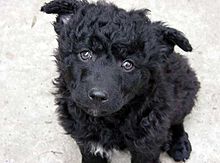
This article contains weasel words: vague phrasing that often accompanies biased or unverifiable information.(December 2010) |

The Croatian Sheepdog is an alert, agile, keen and intelligent dog with enormous energy and with a strong need for human companionship. It is healthy, resistant to disease and not expensive to keep. It possesses a well-developed herding instinct and is an excellent watchdog. [1]
The breed possesses an hereditary predisposition for working cattle. Some farmers affirm that their Croatian Sheepdog knows and will single out every head of cattle by hearing its name.
In the past, the dog was often used to drive herds of pigs to oak woods in autumn, and, in one old document, it states that this versatile breed even herded the horses from Đakovo's stables. It is both a driving and a gathering dog and, depending on whether it comes from a show or working line, its desire to work stock varies. Its approach to the flock may be closer and harder than some other breeds, but is very effective. It may grip but seldom causes any damage thereby.[ citation needed ]
Herding instincts and trainability can be measured at noncompetitive herding tests. Croatian Sheepdogs exhibiting basic herding instincts can be trained to compete in herding trials. [2]
The Croatian Sheepdog probably originates from dogs which the Croats brought with them in the Migration Period. The oldest found record of a Croatian Sheepdog dates from 1374, in which the Bishop of Đakovo, Peter calls him "Canis pastoralis croaticus". [3] This breed was most probably developed over several centuries out of the descendants of the so-called “Pfahlbauhund” in Slavonia, Croatia. Professor Stjepan Romić developed the Croatian Shepherd Dog as a breed in the year 1935. The breed was first publicly presented at the first state dog show in Zagreb in 1949. Dr. Otto Rohr wrote the first breed standard in the year 1951, which was then published by the FCI in 1969. [4]

The Australian Kelpie, or simply Kelpie, is an Australian sheepdog capable of mustering and droving with little or no guidance. It is a medium-sized dog and comes in a variety of colours. The Kelpie has been exported throughout the world and is used to muster livestock, primarily sheep, cattle and goats.

The Shetland Sheepdog, often known as the Sheltie, is a breed of herding dog that originated in the Shetland Islands of Scotland. The original name was Shetland Collie, but this caused controversy amongst Rough Collie breeders of the time, so the breed's name was formally changed. This diligent small dog is clever, vocal, excitable and willing to please. They are incredibly trustworthy to their owners to the point where they are often referred to as "shadows" due to their attachment to family. This breed was formally recognized by The Kennel Club (UK) in 1909.
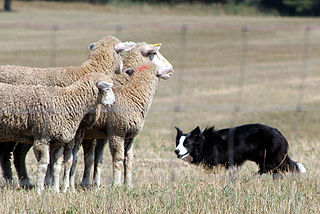
A sheepdog trial — is a competition or test for working abilities of herding breeds dogs. It is a type of dog sport that emerged in the 1860s in New Zealand. By the 1870s regular trials were also being held in Australia and the United Kingdom, and by the end of the 20th century gained popularity in many countries of the world. In competition, dogs demonstrate basic herding management skills assessed by the judge. International and national cynological and sports organisations, sheep and cattle breeders' societies are involved in organising these events. Usually competitions are held with sheep, sometimes other animals are used: ducks or cows.

The Mudi is a herding dog breed from Hungary. It is closely related to the Puli and Pumi, from which it was separated in the 1930s. They continue to be used in herding, as well as participating in a variety of dog sports.

A herding dog, also known as a stock dog, shepherd dog, sheep dog or working dog, is a type of dog that either has been trained in herding or belongs to breeds that are developed for herding.

Collies form a distinctive type of herding dogs, including many related landraces and standardized breeds. The type originated in Scotland and Northern England. Collies are medium-sized, fairly lightly-built dogs, with pointed snouts. Many types have a distinctive white color over the shoulders. Collies are very active and agile, and most types of collies have a very strong herding instinct. Collie breeds have spread through many parts of the world, and have diversified into many varieties, sometimes mixed with other dog types.
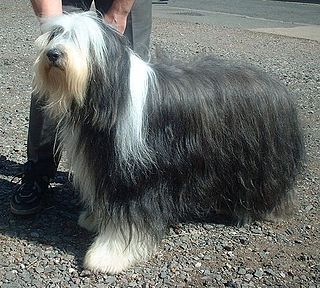
The Bearded Collie, or Beardie, is a herding breed of dog once used primarily by Scottish shepherds, but now mostly a popular family companion.

The Catalan Sheepdog is a breed of Catalan Pyrenean dog used as a sheepdog. This dog is bred in Europe, especially in Spain, Finland, Germany, and Sweden.

The Bouvier des Flandres is a herding dog breed originating in Flanders, Belgium. They were originally used for general farm work including cattle droving, sheep herding, and cart pulling, and nowadays as guard dogs and police dogs, as well as being kept as pets. The French name of the breed means, literally, "Cow Herder of Flanders", referring to the Flemish origin of the breed. Other names for the breed are Toucheur de Boeuf, Vlaamse Koehond, and Vuilbaard.
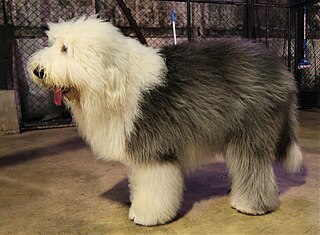
The Old English Sheepdog is a large breed of dog that emerged in England from early types of herding dog. Obsolete names for the breed include Shepherd's Dog and bob-tailed sheep-dog. The nickname Bob-tail originates from how dogs of the breed traditionally had their tails docked. Old English Sheepdogs can grow very long coats with fur covering the face and eyes and do not shed unless brushed.
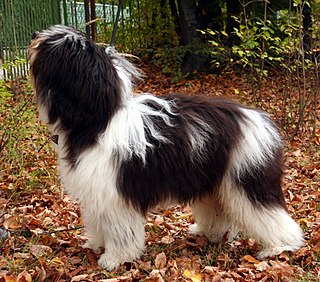
The Polish Lowland Sheepdog, is a medium-sized, shaggy-coated, sheep dog breed native to Poland.

The Lancashire Heeler is a small breed of dog developed for use as a drover and herder of cattle. The Lancashire Heeler is listed by the Kennel Club (UK) as an endangered breed.

The Pumi is a medium-small breed of sheep dog from Hungary. They are versatile stock dogs equally adept at gathering, driving and keeping stock under control. They have a long head with semi-erect ears, a whimsical expression, and a tail that forms a circle over the back. The coat is a combination of wavy and curly hair forming curls all over the body.

The Berger Picard or Picardy Shepherd, is a French herding dog originating in Picardy. These dogs nearly became extinct after both World War I and World War II and remain a rare breed.

The Lapponian Herder is a breed of dog from Finland, one of three Lapphund breeds developed from a type of dog used by the Sami people for herding and guarding their reindeer.

The Portuguese Sheepdog is a medium-sized breed of dog of the herding dog type, and is one of the indigenous regional dogs of Portugal. The Portuguese name refers to Serra de Aires, a mountain near Montforte in the Alentejo region. The breed is nicknamed cão macaco for its furry face and lively attitude.

The Welsh Sheepdog is a breed of herding dog of medium size from Wales.
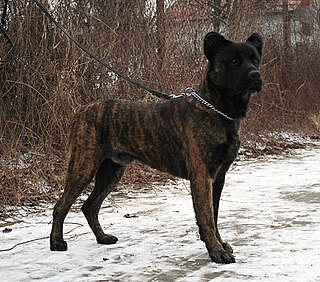
The Saint Miguel Cattle Dog is a dog breed of mastiff type originating on São Miguel Island in the Azores, an island chain which is one of the autonomous regions of Portugal. The breed was originally used as a herding dog for working with cattle.

The Carea Leonés is a breed of herding dog from León, Castile and León, Spain (Europe), and is used as a sheepdog. For centuries, they tended flocks of Churra (sheep) in the mountains of the historical region of León.
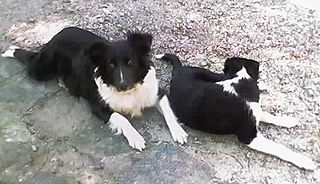
The Gaucho Sheepdog (Portuguese: Ovelheiro gaúcho) is a dog breed that originated in the Pampas, Brazil. The breed is not recognized by the Fédération Cynologique Internationale (FCI), but it has been recognized by the CBKC, a Brazilian kennel club affiliated with FCI. Dogs of this breed are often characterized as sturdy and agile, which makes them suitable for herding activities. The Gaucho sheepdog is widely used for herding sheep and other livestock, especially in the southern region of Brazil.
http://www.bordercollie.hr/HO&ovce.jpg
http://www.bordercollie.hr/Apolonhead01.jpg